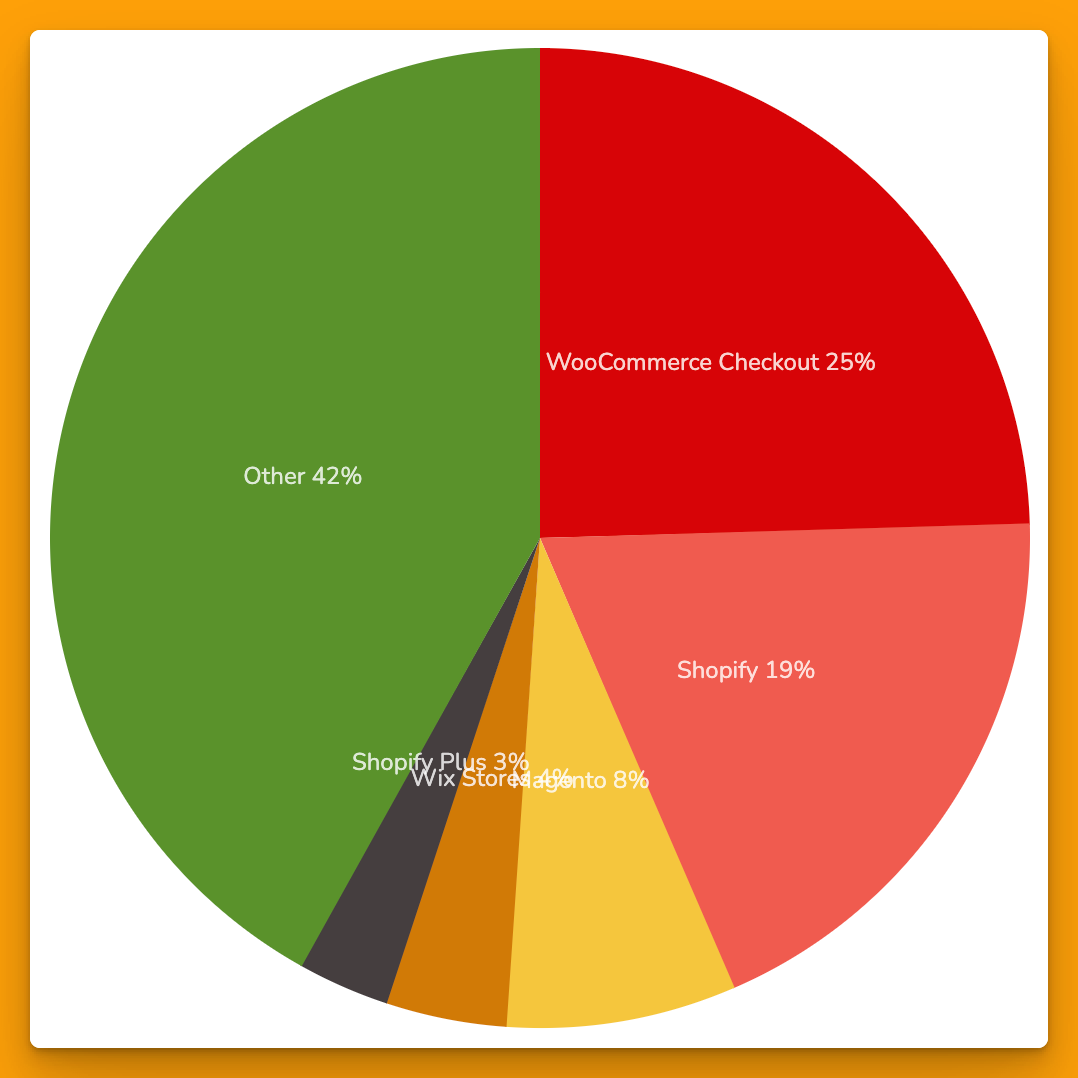In 2023, the global e-commerce market reached a new high – $21.1 trillion. But with an expected growth of 27.16% predicted from 2024, this will be closer to $70.9 trillion by 2028. It’s also expected that by 2040, around 95% of all purchases will be through e-commerce.
So if you’re looking to step into the world of e-commerce, or to expand your existing presence, one of the major decisions you’ll need to make is what e-commerce platform to use. Generally, the decision is between WooCommerce and Shopify, and making the right choice early on will make a huge difference to how much of the pie you’ll enjoy.
In this article, we’re taking a close look at both e-commerce platforms, providing you with all the information you need to make the right choice for your online store.
An Introduction to WooCommerce
WooCommerce was initially released in 2011, five years after Shopify, and is an open-source e-commerce plugin for the world’s leading content management system – WordPress.
As an open-source solution, the WooCommerce core is free to use and easily runs on top of existing WordPress websites. Meaning it can be installed just like any other WordPress plugin. This also means that, unlike Shopify, you’re free to turn to a WordPress hosting provider of your choice and don’t have to tie yourself in.
The WooCommerce team themselves, as well as the incredible WordPress development community, maintain the ecosystem, which lends to the flexibility of the platform to handle anything from a simple online store with a handful of products to DTC brands and e-commerce retailers that generate seven, eight and even nine figures in revenue per year.
Although the WooCommerce core is free, most stores will use extensions to add functionality and improve the overall experience for their customers. Whether in terms of payment methods, subscriptions (something known to be a big weak point for Shopify), or checkout flow – virtually anything you can think of can be customized. These customizations could include existing extensions built by the incredible community or by something built specifically for your use case.
Many are sold on WooCommerce quite easily, simply because they know they can easily add support for subscriptions. Moiz Ali, Founder of Native, the fastest-growing CPG brand in the US, and who regularly dispels e-commerce myths, had this to say on Twitter about Shopify subscriptions:

Note: There are also third-party subscription options available for Shopify, although many of the reviews are rather critical.
Subscriptions are important to many store owners, given the average customer spends $273 every month on subscriptions alone.
Fortunately, when it comes to WooCommerce, you have the WooCommerce Subscriptions plugin, built by the core WooCommerce team. Enabling support for subscriptions is as easy as installing a plugin.
It’s sometimes been suggested by competing alternatives to WooCommerce that a massive and well-established community backs it, and it’s this very community that has resulted in WooCommerce becoming so flexible and offers so much variety when it comes to both appearance and function.
An Introduction to Shopify
Shopify is a hosted, full-service SaaS e-commerce platform, as of 2022, powers 19% of e-commerce websites (2nd after WooCommerce).

This data is from BuiltWith’s dataset of the top one million live e-commerce websites worldwide. This data also shows that WooCommerce is being used to power a slightly larger slice of the e-commerce pie, at 25%.
It’s also worth noting that from 2012 to 2022, WordPress grew from powering 15.8% of the web to a staggering 43% of all websites.
Despite having a reasonable slice of the market share in e-commerce, Shopify hasn’t had an easy ride of late. During the summer of 2022, Shopify reduced its workforce by around 10%, with some significant leadership changes later in the year.
Perhaps as part of this drive to cut costs (or increase returns for shareholders), Shopify has recently announced a range of major increases to its pricing. This will affect all new merchants immediately, with existing store owners having to face the choice of either accepting the significant price hikes within three months or beginning to look for an alternative home for their site (such as WooCommerce).
Previously, Shopify offered a 50% discount on annual subscriptions compared with paying monthly, but this has been slashed to just a 25% discount.
Prices for the Basic tier have increased from $29 to $39 per month, the Shopify package has increased from $79 to $105 per month, and the Advanced package has rocketed by $100 every month from $299 to $399.
This, of course, highlights the very serious issue with choosing to commit your e-commerce site to a platform where a company controls everything, compared with having a hosted solution such as WooCommerce, where you own everything and have complete control and ownership of everything forever.
WooCommerce vs. Shopify – The Overview
The short answer to choosing the best platform for most people is to opt for WooCommerce. It’s flexible and offers a better choice for businesses looking for complete ownership and control.
Shopify is a great, simple solution for businesses wanting to get up and running quickly, with no hassle and the reassurance of having a company maintain and run the system behind the scenes. However, it’s important to consider that this initial ease and reassurance do come at a cost – ownership and control, and that’s where WooCommerce offers a clear benefit.
If you want a simple, ready-made solution, choosing Shopify is a valid choice. However, for most people, we wouldn’t advise it due to the limitations of using Shopify’s closed-source system compared with WooCommerce – an open-source platform that you can easily extend.
There are several good reasons to choose WooCommerce:
- Easy to extend.
- Open-source (which means freedom and true ownership).
- You can’t be shut down without notice.
- It’s easy to hire developers for genuine functionality customization vs. some light theme editing/styling.
- The community.
- Performance and scale.
- Pricing (built for e-commerce owners that want to grow without concern over platform constraints).
And the list in favor of WooCommerce does go on.
So, here’s a quick overview of some of the important differences among the key factors most people use to make their decision of which e-commerce platform to use:
Pricing: The WooCommerce core is free, with paid extensions available for certain functionality. Shopify’s standard tiers start at $9 through to $299 per month (though the price can increase to $2,000, depending on your use case).
Hosting: You can host your WooCommerce store with a hosting provider of your choice that you can rely on. With Shopify, you’re tied into their closed-source platform, meaning that they host data on their servers (which you have no control over).
Support: WooCommerce offers email support for paying customers, extensive documentation, and an active community. You may also be able to take advantage of the support provided by your web hosting provider (such as Servebolt). Shopify offers both chat and email support.
Customization / Flexibility: WooCommerce is the clear winner here – offering considerably more flexibility. WooCommerce is an ecosystem with the ability to build your own plugins thanks to the extensive documentation and community. Shopify operates a marketplace where they offer their own pre-selected apps that can extend parts of your site.
Payment Gateways: Some WooCommerce plugins may charge separately depending upon customized setups. Their own ‘WooCommerce Payments’ system is free to install, with a 2.9% + $0.30 per transaction. So far, this is available across 17 countries, including the UK, the US, Australia, France, Canada, and Hong Kong.
Shopify includes its own payment gateway with no transaction fees. If you wish to use your own payment gateway, Shopify charges a surcharge of an additional 2% per transaction.
Internationalization Support: WordPress offers various ways to add support for internationalization, including TranslatePress (and many more) – most of which follow the general WordPress and open-source approach of either being entirely free or charging a yearly subscription (of between $29) or a one-time fee of $195.
Shopify is limited to US English, although additional languages and currencies are available by using Langify, a Shopify app that costs an additional $17.50 per month.
WooCommerce vs. Shopify – Pricing
At first glance, WooCommerce seems to be much cheaper than Shopify – which, as you grow, will certainly prove to be the case.
That being said, simply because the WooCommerce core is free doesn’t mean there are no costs involved in running a store.
Shopify has three main simple pricing plans – Basic Shopify (up by $10 to $39/month), Shopify (up by $26 to $105/month), and Advanced (up by $100 to $399/month). These include hosting that is tied into their infrastructure/platform.

You will also pay up to 2.192% + 67¢ USD per transaction (depending on your subscription and the payment method used). The cost of operating an e-commerce store on Shopify scales rapidly as you wish to use premium themes and applications, add support for external payment gateways, and so forth.
WooCommerce, on the other hand, is fundamentally free of charge to own and operate, and you get to pick a WooCommerce hosting provider of your choice (like us!). Depending on your store’s requirements (i.e., how you want it to look and function), you may spend some money on premium WooCommerce themes and official WooCommerce extensions. And as such, you pay the fees from the payment gateways such as Stripe directly (not independent prices).
This means that you can’t quote an exact price for a WooCommerce store without knowing anything about the store itself. However, it tends to be more cost-effective, in addition to affording you greater flexibility as a solution in the long term as compared to Shopify.
WooCommerce vs. Shopify – Flexibility and Customization
Which would you prefer? Complete flexibility and customization, which may take additional time initially to know you’ll be in good hands in the long term and can easily customize your store as you see fit. Or, an off-the-shelf solution with basic customization options that allow for a more immediate and simpler setup process?
That’s the real choice between Shopify and WooCommerce regarding their flexibility and customization. If you don’t mind flexibility and how good of a fit your choice will end up being in the long-term, Shopify is a great choice as it is easier to get up and running and takes care of several things that, while simple, are your responsibility with WooCommerce.
So if that’s what you’re looking for, it may be the ideal solution. That being said, for most mid to large-sized businesses or businesses that want to plan ahead – many will want much more out of their e-commerce platform as they grow. And this is where WooCommerce excels – with the sheer amount of choice and what can be done with the platform when extending it with custom development and existing free and paid extensions.
WooCommerce vs. Shopify – How Easy is It to Launch a Store?
When it comes to getting up and running, ready to sell fast, even we consider Shopify the winner. With WooCommerce, you’ll need a WordPress website (or build one) and separately set up hosting and your domain name.
Although it is more time-consuming to get set up with WooCommerce, this is a sacrifice that many (and we’d agree) consider worth making, given the additional flexibility, portability, and freedom to build as you wish.
WooCommerce’s setup process is equally quite simple once you have a WordPress site up and running, with an easy-to-use setup wizard that guides you through the process.
WooCommerce vs. Shopify – How Secure Will Your Store Be?
As you begin to run your e-commerce store and customers make purchases, you will have access to personal information and credit card and debit card details.
This makes security even more important than for your average site, as e-commerce stores tend to be a more interesting target for hackers. Fortunately, the basics are easy to set up out of the box with most WordPress hosting providers – such as getting an SSL certificate which is the most basic level of security in this day and age.
For WooCommerce, there are additional services and plugins you can run that help ensure none of your directories are compromised. However, here at Servebolt, we host countless successful e-commerce stores and can confidently say that the most fundamental step for true peace of mind is going with a managed WordPress hosting provider that knows what they’re doing and has experience handling e-commerce at scale.
Servebolt Managed Hosting enables WordPress developers and teams to focus 100% of their working hours on development and improvements. We take care of server updates, optimization, security upgrades, patches, and dealing with possible hardware failures, network outages, and all the other things that can happen.
You and your team can focus on developing the best store possible – and making money.

As Shopify is a hosted solution, their team, as they also host and maintain all stores on the platform, is responsible for handling the security of stores. They also have a bug bounty program that encourages ethical hackers to test their security, with rewards for any information that leads to their team being able to tighten up security further.
WooCommerce vs. Shopify – Backing Up Data
There are two main reasons you’ll want to have secure backups of your site:
- In case of storage failures.
- In case of inadvertent changes to or the accidental deletion of content, such as themes or plugins, which could break the site.
It’s essential to know what steps you will take to protect your business for both of these eventualities.
Shopify offers a strong solution as far as the first risk is concerned but nothing at all for the second type of risk, although third-party paid plugin solutions are available. All you can do is export your data as a CSV and re-import it into a separate Shopify store.
With WooCommerce, on the other hand, you have complete freedom to host your site where you want – ideally with a host that has experience in delivering performance and scaling e-commerce. As such, you can choose a hosting provider that runs their own backups and use an additional service for extra peace of mind – meaning you can also easily create staging environments, clone your store to test visual changes, rollback, and more.
Note: This is not to say that Shopify does not back up your data, including products, images, customers, financial data, etc., frequently. Although, they do not share much regarding how frequently data is backed up, which, as a user, should be disconcerting.
WooCommerce vs. Shopify – Performance
Everything we do at Servebolt ties back into our mission of building a sustainable and fast internet. It would be very easy for us to draw on our experience of hosting WooCommerce to explain how we see it outperforming other platforms. But to make the comparison objective, and since this data isn’t available elsewhere, let’s look at how the performance of WooCommerce and Shopify websites stack up.
Total Number of e-commerce Stores Tested: 40
We tested 40 sites with an even split between WooCommerce and Shopify-powered e-commerce stores. For this post, we based our testing on the Core Web Vitals metrics developed by Google, using PageSpeed Insights. This was also because this metric is increasingly becoming the most relevant in terms of assessing performance, as it relates directly to user experience (as opposed to load times and other speed-related metrics easily affected by other variables).
Other considerations: Given that WooCommerce as a platform is far more flexible than Shopify, the initial expectation will be that, while we still anticipate a noticeable edge given to WooCommerce, it won’t fully reflect the differences in performance between the platforms.
This is because Shopify requires sites to be hosted with them and built within specific constraints (which simplifies performance to a certain extent). Although not all WooCommerce sites are built with performance as a top priority or hosted with a company such as Servebolt to ensure they’re running on the world’s fastest hosting platform.
Note: All sites tested were randomly selected based on data from BuiltWith on sites powered by WooCommerce and Shopify, respectively. After this, we also independently verified that this was still the case as we performed our testing.
There’s no question that bad performance isn’t platform-independent. Both WooCommerce and Shopify can be implemented to run in a way that doesn’t perform well.
Yet, across the board, comparisons of Core Web Vitals show a significant difference with an edge over WooCommerce.
And this still excludes the consideration that WooCommerce can run in different environments. This means that its performance is expected to be less controllable than that of Shopify since Shopify as a platform already imposes constraints on the actual design and development of your store as well as controls the hosting layer. If we were to run these tests with sites only hosted on the Servebolt Cloud – this would further exaggerate the difference in favor of WooCommerce.
Interested in managed hosting that’s empirically faster? Try the Servebolt way:
- Scalability: In the real user workload tests, Servebolt delivered average response times of 65ms, 4.9x faster response times than the second best.
- The fastest global load times: The average page load times of 1.26 seconds put on at the top of the list of global WebPageTest results.
- The fastest computing speed: Servebolt servers provide unheard-of database speed, processing 2.44 times more queries per second than the average and running PHP 2.6 times faster than the second best!
- Perfect security and uptime: With 100% uptime on all monitors and an A+ rating on our SSL implementation, you can be assured your site is online and secure.
All backed by our expert team and ready to take for a spin on your free test Bolt today.
WooCommerce vs. Shopify – The Verdict
Making a definitive decision for you without knowing you, your business, or your plans for your e-commerce store – is hard to generalize.
That being said, what we can say is:
- Shopify is great for getting up and running quickly, offering a simple platform that requires very little technical understanding.
- WooCommerce is incredibly flexible and allows you to build more than just an e-commerce store on top of the world’s leading content management system. The ability to build what you want here is virtually limitless.
And, if you do decide to go the WooCommerce route – create a free test Bolt on us to take a look around the platform and see how fast your store could be when backed by our expert team and a stack that’s been perfected over years of working with e-commerce.
Any specific questions about WooCommerce and Shopify? Let us know by Tweeting @Servebolt! 💬


